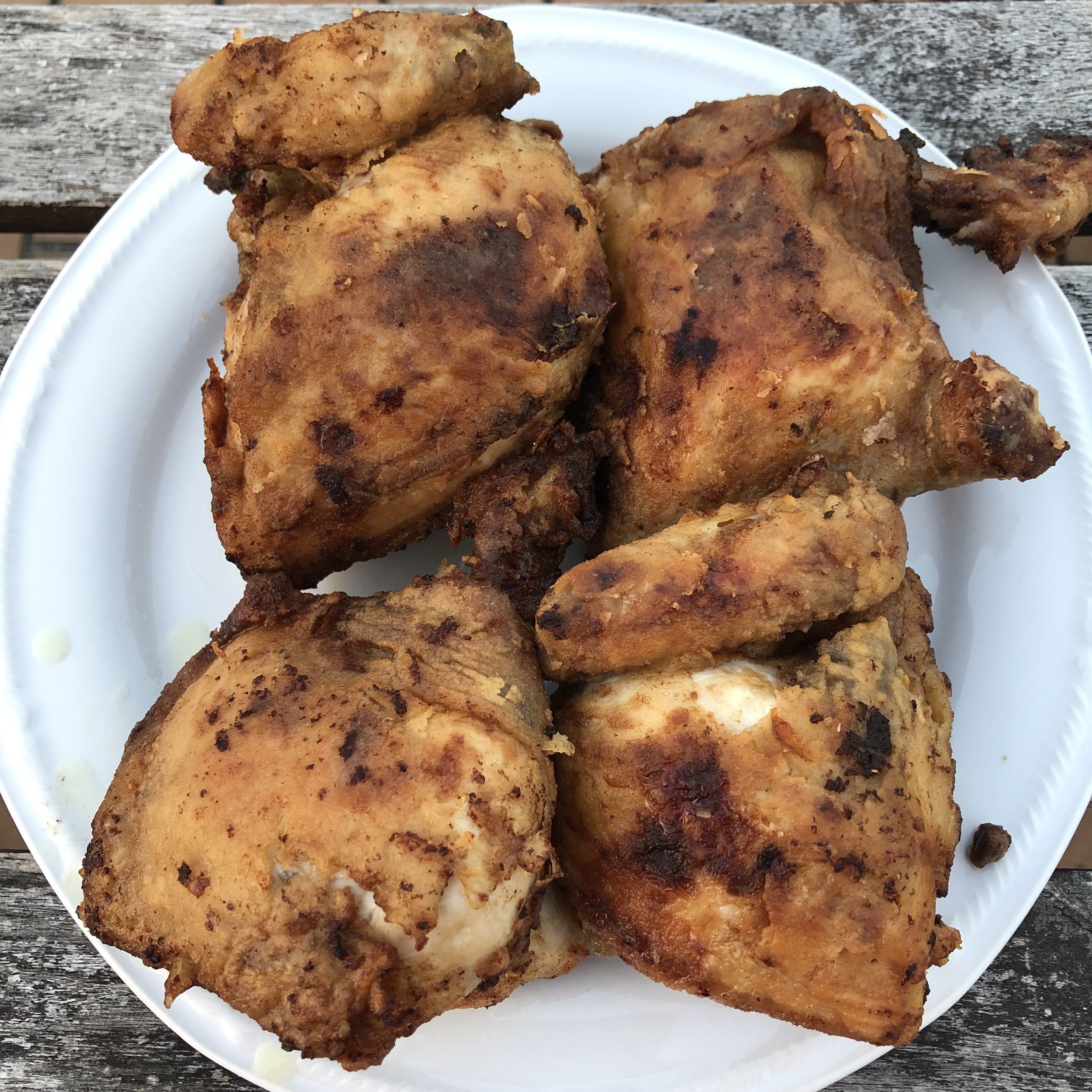Bartolomeo Scappi, Opera (1570), Book II, recipe 126 “Various ways to sauté a capon”
The recipe featured here calls for capon that has been marinated and deep-fried. Capons and pullets were common fare on the well-to-do table in Renaissance Rome; the former were roosters that had been castrated, which enhanced plumpness, and the latter, at the other end of the continuum, were chicks that had not yet reached laying age. The fact that these fowl were removed from the cycle of egg laying and reproduction was a statement of elite consumption. Castration replaced forced feeding as the solution to fattening chickens when Roman sumptuary laws forbad the practice. But as chickens in the 16th century were rather scrawny affairs, and today’s birds are bred for fleshiness, the capon can be swapped out for a local, sustainably-farmed chicken.
Other historical curiosities: Scappi explains that decapitated fowl will be tastier if plucked dry as opposed to immersing them in hot water; decapitation is preferable to neck wringing to keep the meat whiter. Maintaining optimal whiteness seems to have been particularly desirable in the Renaissance. If it is necessary to butcher them in advance, they should be plucked, gutted, and cleaned, and the inside cavity should be sprinkled lightly with salt, ground pepper and fennel seed, after which it should be packed with nettles to deter flies. The birds should be strung up in a cool, airy place taking care that they are spaced so as not to touch each other. In summer, a capon can be kept this way for up to three days.
Now, on to our recipe.
This recipe results in meat that is delicately aromatic, pleasantly pungent, and satisfyingly salty. And, as they say in Italian, if you’re frying, even your house slippers are good.
500ml white wine
200ml white wine vinegar
100ml must (or 50ml pomegranate syrup + 2 tsp. sugar)
50g salt
1/4 tsp ground cloves
1/4 tsp ground nutmeg
1 tbsp ground black pepper (preferably mix of 4)
1 1/2 tbsp ground corriander
10 cloves garlic smashed
500-700g capon or chicken cut into quarters or pieces
All-purpose flour for coating
Oil for shallow frying
Instructions:
1. Prepare the marinade liquid:
Put all of the ingredients except the last three together in a reaction-proof container (glass).
Notes on ingredients:
Wine: even a cheapo boxed white wine is fine for this. Vinegars vary in pungency, so move according to your intuition here. We are going for a pickling effect. Must (mosto cotto) is grape juice that has been cooked down and reduced to a syrup. It is not as decisive as pomegranate syrup, so if subbing, go easy. Date syrup might also be acceptable, but it is sweeter, so again, reduce the quantity when substituting.
I grind all of my own spices, so if you are using pre-ground spices you may get a subtler effect than I did with the same quantities. The four-pepper mix is 2 parts black pepper, 1 part cubebe pepper, 1 part long pepper, and 1 part Sichuan pepper. Grind to a medium coarseness. Just black pepper is perfectly fine but better if it is freshly ground.
Stir the lot until the salt has dissolved.
2. Cook the chicken a bit more than halfway either by boiling it or in an inch of water in a pressure cooker. Either way you end up with broth that you can chuck away for some other use. Broth is very useful to have on hand for historical cooking.
3. Immerse the capon or chicken pieces into the marinade, cover and refrigerate for 6 hours. Remove from marinade and pat dry.
4. Coat completely with the flour.
5. Pour 3cm of oil into a wide skillet. Here Scappi says to fry in rendered lard. Do as you see fit. I used a sunflower frying oil that is called Friol. Heat the oil to 180°. It needn’t be excessively hot because the cooking is only to finish the pre-cook and to create a crispy crust. Once you immerse the pieces in the oil, turn up the heat to bring it back to the proper temperature. Fry on medium. Although the original says to quarter the bird, sectioned pieces are more manageable in a home kitchen.
6. Continue frying until golden brown, turning occasionally. This is best served hot.
7. Alternatively, Scappi says that capon prepared this way can be cooked on the grill, without, of course, flouring it.








